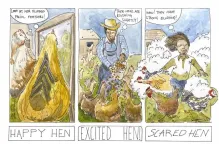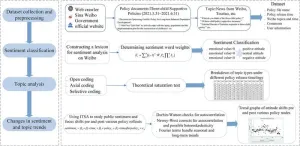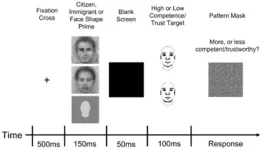(Press-News.org) Mice don’t get Alzheimer’s—and while that’s good news for mice, it’s a big problem for biomedical researchers seeking to understand the disease and test new treatments. Now, researchers at The Jackson Laboratory are working to create the first strain of mice that’s genetically susceptible to late-onset Alzheimer’s, with potentially transformative implications for dementia research.
In humans, two of the defining traits of Alzheimer’s disease are amyloid plaques between brain cells, and tangles of tau proteins within neurons. In mice, however, intercellular plaques don’t give rise to intracellular protein tangles, so mice don’t develop significant cognitive impairments. “It’s easy enough to create mouse models for studying amyloid plaques,” said Greg Carter, the Bernard and Lusia Milch Endowed Chair at JAX who also leads the Model Organism Development and Evaluation for Late-onset Alzheimer’s Disease (MODEL-AD) consortium with JAX colleagues Gareth Howell, Ph.D. and Mike Sasner, Ph.D. “But that replicates only a very limited aspect of Alzheimer’s—and if we could cure the disease with those models, we’d have done it 20 years ago.”
To develop new mouse strains that accurately reflect the full complexity of Alzheimer’s disease, Carter’s team drew on recent genome-wide studies that have identified over 70 genes associated with the illness. Using CRISPR gene editing, they collaborated with Sasner and Howell at JAX to introduce different genetic factors associated with Alzheimer’s into 11 separate strains of mice, and raised the mice to maturity to explore how the genetic variants affected their brain health.
That presented a separate challenge: how can you tell when a mouse is developing Alzheimer’s? “Mice aren’t very smart, so it’s really hard to check whether a disease is impacting their cognitive abilities,” Carter explained, whose work appears in the July issue of Alzheimer’s & Dementia, the journal of the Alzheimer’s Association. “Any behavioral metric can be easily confounded by other factors like hyperactivity or sensory impairment, so focusing on mouse cognition has really led the field astray.”
To get around that problem, the JAX team used transcriptomics—a technique that reveals the way genes are transcribed and “activated” within cells—to compare the biological signatures present in mouse brains to those of deceased human Alzheimer’s patients. “By comparing the molecular biology of mouse and human brains, we can see where the two overlap, and what part of the Alzheimer’s disease biology a particular gene is driving,” Carter said. “It’s a way to very systematically map out the disease-relevant contributions of all 11 different genetic variants.”
Using transcriptomics also creates a clearer benchmark for testing new therapeutics: if a treatment aims to prevent inflammation associated with Alzheimer’s, for instance, it’s possible to evaluate its impact on the transcriptome signature specifically associated with inflammation. “This approach can assess whether a treatment is working at the molecular level, without worrying so much about behavioral changes that are hard to spot in mice,” said Carter. “For pre-clinical studies, it’s much more precise and efficient.”
First, however, Carter and team need to map the contributions of each individual genetic factor, then figure out how to combine them into a single mouse strain that shows all the key biological hallmarks of Alzheimer’s. In a separate project, Carter’s team tested about a dozen additional genes; now, they are working to find the most effective way to combine the genes into a single mouse model. “We’ve used machine learning to figure out how to combine the genes we’ve studied,” Carter said. “Now, we’re setting up studies that will combine three or four genes at a time, and hopefully give us mice with much more complete Alzheimer’s.”
That’s an important step forward, given that most mouse-model research into dementia focuses on the impact of single genes. “While different genes may increase your risk of dementia, no single gene causes Alzheimer’s—that’s not how complex genetics works,” Carter explained. Working at JAX made it possible to raise multiple strains and study dozens of genes in parallel, and ultimately to home in on the best possible model for studying Alzheimer’s Disease,” Carter said
“We know how valuable it would be to have a mouse model for Alzheimer’s disease,” he added. “This research is bringing that goal within reach.”
END
Researchers are closing in on a mouse model for late-onset Alzheimer’s
The Jackson Laboratory and MODEL-AD breakthrough could accelerate efforts to understand and treat dementia.
2024-07-24
ELSE PRESS RELEASES FROM THIS DATE:
New analysis offers most comprehensive roadmap to date for more targeted Alzheimer’s research and drug discovery
2024-07-24
From studying the human genome, to analyzing the way proteins are encoded, or monitoring RNA expression, researchers are rapidly gaining a far richer understanding of the complex genetic and cellular mechanisms that underpin dementia. But there’s a catch: While new technologies are revealing myriad avenues for Alzheimer’s research, it’s impossible to know in advance which research pathways will lead to effective treatments.
“We have countless potential targets, but we don’t know which ones to aim at,” said Greg Carter, the Bernard and Lusia Milch Endowed Chair at the ...
Hens blush when they are scared or excited
2024-07-24
Hens fluff their head feathers and blush to express different emotions and levels of excitement, according to a study publishing July 24, 2024, in the open-access journal PLOS ONE by Cécile Arnould and colleagues from INRAE and CNRS, France.
Facial expressions are an important part of human communication that allow us to convey our emotions. Scientists have found similar signals of emotion in other mammals such as dogs, pigs and mice. Although birds can produce facial expressions by moving their head feathers and flushing their skin, it is unclear whether they express emotions in this way. To investigate, researchers filmed ...
Weibo posts illuminate public response to China’s three-child policy measures
2024-07-24
An analysis of comments on Chinese social media platform Sina Weibo reveals trends in the public response to measures implemented to support China’s three-child policy, highlighting concerns about women’s rights and employment. Lijuan Peng of Zhejiang Gongshang University in Hangzhou, China, and colleagues present these findings in the open-access journal PLOS ONE on July 24, 2024.
For decades, China’s one-child policy restricted most families to having just one child. In 2021, to combat a falling birthrate, China introduced its three-child policy, allowing couples to have up to three children. To help encourage childbirth, ...
Our ability to recognize music might not diminish with age, with older concert attendees identifying themes in music as well as younger participants
2024-07-24
Our ability to recognize music might not diminish with age, with older concert attendees identifying themes in music as well as younger participants
###
Article URL: https://journals.plos.org/plosone/article?id=10.1371/journal.pone.0305969
Article Title: Age and familiarity effects on musical memory
Author Countries: Canada, UK
Funding: The author(s) disclosed receipt of the following financial support for the research, authorship, and/or publication of this article: this work was supported by BRZ’s Natural Sciences and Engineering Research Council of Canada grant. The funders had no role ...
The COVID-19 pandemic slowed progress towards health-related Sustainable Development Goals and increased inequalities
2024-07-24
The COVID-19 pandemic significantly widened existing economic and health disparities between wealthy and low-income countries and slowed progress toward health-related Sustainable Development Goals (SDGs), according to a new study published July 24, 2024, in the open-access journal PLOS ONE by Wanessa Miranda of Federal University of Minas Gerais, Brazil, and colleagues.
The global SDGs were established in 2015 as a wide and integrated agenda with themes ranging from eradicating poverty and promoting well-being to addressing socioeconomic ...
Even people who harbor positive sentiments toward immigrants imagine immigrants' faces as less trustworthy and less competent than US citizens' faces
2024-07-24
Even people who harbor positive sentiments toward immigrants imagine immigrants' faces as less trustworthy and less competent than US citizens' faces
###
Article URL: https://journals.plos.org/plosone/article?id=10.1371/journal.pone.0306872
Article Title: Intergroup evaluative bias in facial representations of immigrants and citizens in the United States
Author Countries: USA
Funding: This work was facilitated by the National Science Foundation Division of Behavioral and Cognitive Sciences, grant #1764097 awarded to ART and grant #2215236 awarded to ...
Southern Ocean absorbing more CO2 than previously thought, study finds
2024-07-24
New research led by the University of East Anglia (UEA) and Plymouth Marine Laboratory (PML) has found that the Southern Ocean absorbs more carbon dioxide (CO2) than previously thought.
Using direct measurements of CO2 exchange, or fluxes, between the air and sea, the scientists found the ocean around Antarctica absorbs 25% more CO2 than previous indirect estimates based on shipboard data have suggested.
The Southern Ocean plays a major role in absorbing CO2 emitted by human activities, a process vital for controlling the Earth's climate. However, there are big uncertainties ...
Saharan dust regulates hurricane rainfall
2024-07-24
Giant plumes of Sahara Desert dust that gust across the Atlantic can suppress hurricane formation over the ocean and affect weather in North America.
But thick dust plumes can also lead to heavier rainfall – and potentially more destruction – from landfalling storms, according to a July 24 study in Science Advances. The research shows a previously unknown relationship between hurricane rainfall and Saharan dust plumes.
“Surprisingly, the leading factor controlling hurricane precipitation is not, as traditionally thought, sea surface temperature or humidity in the atmosphere. Instead, it’s Sahara dust,” said the corresponding ...
Fighting leukemia by targeting its stem cells
2024-07-24
Acute myeloid leukaemia is one of the deadliest cancers. Leukaemic stem cells responsible for the disease are highly resistant to treatment. A team from the University of Geneva (UNIGE), University Hospital of Geneva (HUG), and Inserm has made a breakthrough by identifying some of the genetic and energetic characteristics of these stem cells, notably a specific iron utilisation process. This process could be blocked, leading to the death or weakening of these stem cells without affecting healthy cells. These results, published in Science Translational Medicine, pave the way for new therapeutic strategies.
Acute ...
NASA’s Webb images cold exoplanet 12 light-years away
2024-07-24
An international team of astronomers using NASA’s James Webb Space Telescope has directly imaged an exoplanet roughly 12 light-years from Earth. The planet, Epsilon Indi Ab, is one of the coldest exoplanets observed to date.
The planet is several times the mass of Jupiter and orbits the K-type star Epsilon Indi A (Eps Ind A), which is around the age of our Sun, but slightly cooler. The team observed Epsilon Indi Ab using the coronagraph on Webb’s MIRI (Mid-Infrared Instrument). Only a few tens of exoplanets have been directly imaged previously by space- and ground-based observatories.
“Our prior observations of this system have been more indirect measurements ...
LAST 30 PRESS RELEASES:
Decoupling the HOR enhancement on PtRu: Dynamically matching interfacial water to reaction coordinates
Sulfur isn’t poisonous when it synergistically acts with phosphine in olefins hydroformylation
URI researchers uncover molecular mechanisms behind speciation in corals
Chitin based carbon aerogel offers a cleaner way to store thermal energy
Tracing hidden sources of nitrate pollution in rapidly changing rural urban landscapes
Viruses on plastic pollution may quietly accelerate the spread of antibiotic resistance
Three UH Rainbow Babies & Children’s faculty elected to prestigious American Pediatric Society
Tunnel resilience models unveiled to aid post-earthquake recovery
Satellite communication systems: the future of 5G/6G connectivity
Space computing power networks: a new frontier for satellite technologies
Experiments advance potential of protein that makes hydrogen sulfide as a therapeutic target for Alzheimer’s disease
Examining private equity’s role in fertility care
Current Molecular Pharmacology achieves a landmark: real-time CiteScore advances to 7.2
Skeletal muscle epigenetic clocks developed using postmortem tissue from an Asian population
Estimating unemployment rates with social media data
Climate policies can backfire by eroding “green” values, study finds
Too much screen time too soon? A*STAR study links infant screen exposure to brain changes and teen anxiety
Global psychiatry mourns Professor Dan Stein, visionary who transformed mental health science across Africa and beyond
KIST develops eco-friendly palladium recovery technology to safeguard resource security
Statins significantly reduce mortality risk for adults with diabetes, regardless of cardiovascular risk
Brain immune cells may drive more damage in females than males with Alzheimer’s
Evidence-based recommendations empower clinicians to manage epilepsy in pregnancy
Fungus turns bark beetles’ defenses against them
There are new antivirals being tested for herpesviruses. Scientists now know how they work
CDI scientist, colleagues author review of global burden of fungus Candida auris
How does stroke influence speech comprehension?
B cells transiently unlock their plasticity, risking lymphoma development
Advanced AI dodel predicts spoken language outcomes in deaf children after cochlear implants
Multimodal imaging-based cerebral blood flow prediction model development in simulated microgravity
Accelerated streaming subgraph matching framework is faster, more robust, and scalable
[Press-News.org] Researchers are closing in on a mouse model for late-onset Alzheimer’sThe Jackson Laboratory and MODEL-AD breakthrough could accelerate efforts to understand and treat dementia.






